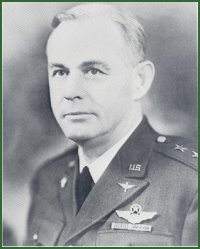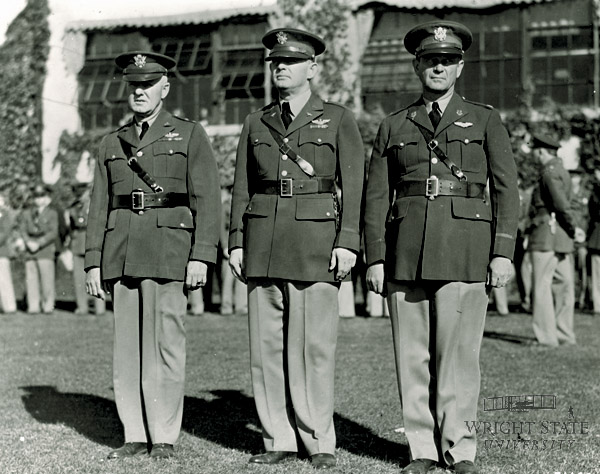MAJOR GENERAL OLIVER P. ECHOLS
Retired December 1, 1946. Died May 15, 1954
Major General Oliver P. Echols was the Air Force’s chief materiel officer throughout World War II. More than any other man under the commanding general of the Army Air Force, General Echols was responsible for the development, procurement and supply of aircraft and aeronautical equipment for the Air Force.
Never, before or since, has our nation been required to bring into being such large numbers of military aircraft. Between July 1940 and August 1945 the Air Force handled the procurement of 230,287 aircraft. The Air Force received more than $43.5 billion worth of air materiel – and aircraft accounted for $82.5 billion of this.
General Echols was assistant chief of the Materiel Division at Wright Field near Dayton, Ohio from 1939 to 1940. As chief of that division, which was headquartered in Washington, he served from 1940 to 1942. In March 1942, a reorganization changed his title to commanding general, Materiel Command, in the Army Air Forces headquarters – a position changed a year later to assistant chief of staff for materiel, maintenance and distribution. Until April 1945 General Echols continued to play the major role in the production of the prime tools of airpower.
The real impetus to aircraft production came in May l940 when President Franklin D. Roosevelt went to Congress with a call for a program of no less than 50,000 “military and naval” aircraft per year for the nation’s defense. (The Air Corps and the Navy Bureau of Aeronautics agreed that the Navy would get 12,500 of these.)
A year and a half later, on Dec. 7, 1941, the airframe weight of U.S. aircraft production increased sixfold – from the rate of 20,000,000 pounds per year, to 120,000,000 pounds. By November 1942 the production rate had tripled again. (50,000 aircraft were being manufactured year1y.) In the following year and a half to June 1944 there was another tripling of production.
From 1941 on, United States aircraft production was much greater than the combined output of Japan and Nazi Germany, and the Air Force of 3,305 combat planes in December 1941 grew to 41,000 in August 1945.
One of General Echols most important yet little known roles was his membership from 1943 to 1945 on the Air Production Board and on the Executive Committee of the War Production Board. He represented the Air Force in the committee task of coordination of all production, and the establishment of priorities for use of tools, materials and manpower within the national war program.
In early 1939 Air Force tactical staffs under General H.H. “Hap” Arnold and Materiel Division engineers under Echols, then a lieutenant colonel, prescribed the military requirements around which the B-29 was to be built. The first production model was completed in July 1943 and 11 months later B-29s were bombing Japan.
While at Wright Field and in Washington, General Echols was known in the profession as the man chiefly responsible for the long, hard process of bringing a plane into being – planes such as the B-24 and the advanced B-17, the B-29, B-50 and the B-36. He helped with the initial planning that led to the B-47 and B-52 and the early jet aircraft.
From May 1945 until he retired in 1947, General Echols served successively as Chief, Internal Affairs for the U.S. Control Council for Germany, as assistant deputy military governor in Germany, and director of Civil Affairs Division of the War Department Special Staff.
But in civilian life General Echols continued to help strengthen the nation’s airpower potential. As president of the Aircraft Industries Association from 1947 to 1949, his reputation for vision, decisiveness and good humor became even more widely appreciated.
He joined Northrop Corporation in 1949 as chairman of the board and chief executive officer. Later, he also was made president and general manager. Under his direction, Northrop’s work force increased from 8,000 to 24,000 employees, and the company’s backlog of orders advanced from $70 million to $557 million at the time of his death on May 15, 1954.
Oliver P. Echols was born in Charlottsville, Virginia, in 1892. He attended Virginia Polytechnic Institute and the University of Virginia.
He served with the U.S. Air Service, American Expeditionary Force, from August 1917 to April 1919, participating in the battles of Champagne-Marne, Aisne-Marne, St. Mihiel and Meues-Argonne.
His educational and military preparation for his later specialization included attendance at the Army Industrial College, Command and General Staff School, Army War College, and Air Corps Tactical School. He held a pilot’s rating. He served in the Air Corps Experimental Engineering Section and the Procurement Section before becoming the chief engineer of the Materiel Division from 1934 to 1938.
This tribute was paid to General Echols in May 1945 by General “Hap” Arnold, Army Air Forces Commanding General.
“No one knows better than you the terrific problems we have faced in the development and perfection of our equipment and in obtaining the necessary production. I know of no one who could have carried the Air Force’s responsibilities in these fields than you have. The task could never have been done had not the Army Air Forces been represented in these matters by an officer having the full confidence of the Congress, the departments and civilian agencies of government, industry and labor. This trust, as well as my own, has been yours and deservedly. The country, the Army Air Forces and I, personally, owe you a real debt of gratitude.”
Aviator, born in Charlottesville, Virginia, USA. Commissioned in the army (1916), he was chief of aviation for the US 1st Army Corps in France during World War 1. As chief of the Army Air Force’s matériel division (1940–5), he helped build the largest and most powerful air force the world had seen. He retired in 1949 to become chairman and chief operating officer at Northrop Aircraft.
Standing at attention, from left to right, are Major General George H. Brett, Lieutenant Colonel Oliver P. Echols, and an unidentified third officer. General Brett was the Chief of the Material Division at Wright Field and Lt. Col. Echols was the Assistant Chief of the Material Division.
Place: Dayton (Ohio) Date: October 12, 1940
“Courtesy of Special Collections and Archives, Wright State University”
Oliver Patton Echols, Major General, United States Army
(1892–1954) USAAF
1930 -1931 Chief of the Aircraft Procurement Section, Air Corps Material Division, Wright Field, Ohio
1931 – 1932 Student at the Air Corps Tactical School, Maxwell Field, Alabama
1932 – 1934 Student at the Command and General Staff School, Fort Leavenworth, Kansas
1934 – 1938 Chief Engineer, Air Corps Material Division, Wright Field, Ohio
1938 – 1939 Student at the Army War College, Washington Barracks, D.C.
1939 – 1940 Assistant Chief of the Air Corps Material Division, Wright Field, Ohio
1940 Officer-in-Charge of Research, Procurement, Supply and Maintenance, Air Corps Material Division, Office of the Chief of the Air Corps, Washington, D.C.
1940 – 1942 Chief of the Air Corps Material Division, Office of the Chief of the Air Corps, Washington, D.C.
1942 – 1943 Commanding General of the Air Material Command, Headquarters U.S. Army Air Forces, Washington, D.C.
1943 – 1944 Assistant Chief of the Air Staff for Material, Maintenance and Distribution, Headquarters U.S. Army Air Forces, Washington, D.C.
1944 – 1945 Assistant Chief of the Air Staff for Material and Services, Headquarters U.S. Army Air Forces, Washington, D.C.
1944 – 1945 Additional duty as member of the Aircraft Production Board and the Executive Committee of the War Production Board
1945 Chief of Internal Affairs, U.S. Control Council for Germany
1945 – 1946 Deputy Commanding General of the Office of U.S. Military Government for Germany, Berlin
1946 – 1947 Chief of the Civil Affairs Division, War Department Special Staff, Washington, D.C.
1947 Retired (disability in line of duty)
Easygoing Jack Northrop, who admits that he is “too softhearted” to be a good boss, knew that he was a better designer than administrator. In 1949 he took a back seat to a new chairman and general manager, Oliver P. Echols, a retired Air Force major general who was chief of Air Force Material & Services in World War II, later served as president of the Aircraft Industries Association. Echols soon shook the soggy company into a model of cost-conscious efficiency. Northrop was left free to do what he liked best: design. And just before Echols came in, Northrop’s Scorpion design landed a $50 million production contract. Echols bossed the production.
Designer Northrop and Administrator Echols made a good team. The company, which had lost $3.9 million in two years, last year came out of the red, showed a $3.2 million profit. This year, with 17,000 workers, almost twice as many as World War II’s peak, it expects to earn more than $2,000,000 after taxes.
Airman Echols says that his main job is to try to guess what the Joint Chiefs of Staff will be wanting five years hence. Northrop’s job is to make them want what he designs. Right now, Northrop is worrying about the “thermal barrier”— the speeds where air friction will disintegrate metal planes. He is experimenting with fuselages made of glass fiber, which will not melt at those speeds. Looking further ahead to the days of pilotless planes, Northrop already has about 14% of his work force on guided missiles, expects a production contract soon. Against rainy days, Northrop Aircraft has no more plans for scooters; instead it is making pilotless target planes, on the assumption that come what may, the Air Force will always need something to shoot at.
ECHOLS, OLIVER PATTON
M/GENERAL USAF
DATE OF DEATH: 05/15/1954
BURIED AT: SECTION 30 SITE 689
ARLINGTON NATIONAL CEMETERY
Michael Robert Patterson was born in Arlington and is the son of a former officer of the US Army. So it was no wonder that sooner or later his interests drew him to American history and especially to American military history. Many of his articles can be found on renowned portals like the New York Times, Washingtonpost or Wikipedia.
Reviewed by: Michael Howard


